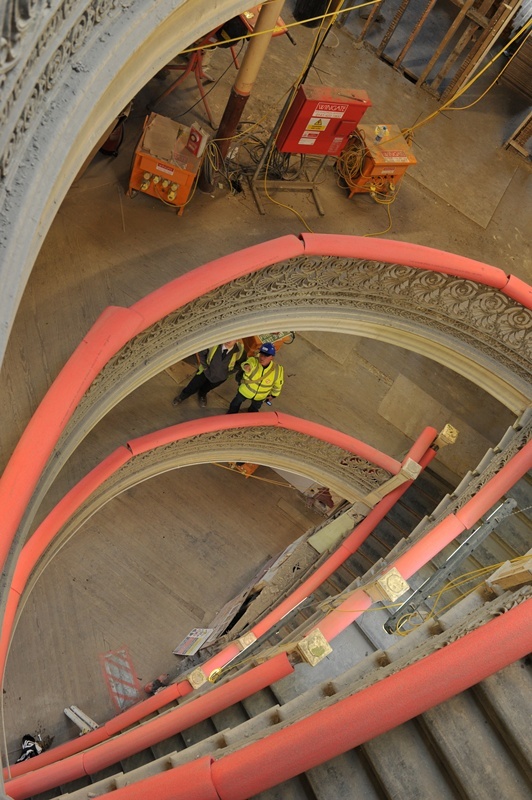An exciting vision of Dundee’s future also provided a nostalgic step back in time for a 73-year-old woman.
Frances Anderson was more interested than most people to see how the city’s prestigious new Malmaison Hotel is taking shape.
As Frances Mathers, she knew the building as her home from the age of eight until she had her wedding in its grand surroundings at the age of 23.
The Malmaison building in Whitehall Crescent was opened by her family as Mathers Hotel in 1899.
”It’s absolutely delightful and also quite emotional for me to be back here after all these years, ” said the former radiographer who now lives in Meigle. ”I can see what the developers are doing and it’s going to be stunning.
”I’m also so impressed that they are going to restore some of the original features. The people who are doing this are taking very great care and attention to their work and are doing a very good job.”
The most eye-catching of the features is the unique MH lettering in the decorative wrought iron filigree of the grand staircase specially created by the Victorian builders.
It lay forgotten encased in cement render until workmen began chipping away to discover what was beneath. Astonished at the detail, and their good fortune in sharing the same initials as the original hotel, the new owners are to restore the decorative metalwork to its former glory.
The staircase was not all that caught Frances’s attention.
In the top floors she found her family’s former living quarters the lounge, bedrooms and kitchen.
When developer Michael Carolan led her out on to the roof of the six-storey building to enjoy the views over the central waterfront, she let her hosts into a secret.
”I used to love coming up here to see over Dundee,” she said. ”It was also a good place to sneak up to dry my hair.”
Frances grew up in Mathers Hotel with her sister Anne and brother David when it was run by her father, David Sr, whose grandfather was the original owner.
Her memories of it are of a place of fun and enjoyment and also an awareness of its status as the No 1 hotel in Dundee of its day.
”It was known as the place to go if you had something to celebrate,” she said. ”So many people came to Mathers Hotel for important events in their lives and I was so proud to have my wedding there in 1962.”
Its special nature was due in part to it being a temperance hotel, its creation inspired by the temperance movement of the 19th century which promoted prohibition of alcohol.
That was a different age, as Frances was amused to reflect when Mr Carolan showed her where the Malmaison’s bars would be situated.
Her family sold the hotel in 1969 and that was when Frances and sister Anne last visited. The passing years brought sadness as she saw the grand hotel fall into disrepair after its years as the Tay Hotel.
”It was the first thing you saw when you came out of the station and it looked terrible,” she said. ”It really broke my heart to see what ‘our’ hotel had become.
”But I’m so pleased that it is being restored and it will be back to being the fine hotel it used to be and which this area needs.”A building with a rich historyDundee businesswoman Margaret Mathers opened a temperance hotel at the top of Union Street in 1860, at a time when the anti-alcohol movement flourished.
Her family then bought a builder’s yard at the bottom of the street and built the present hotel building, opening it in 1899.
Marketed as Mathers Temperance Hotel it was in a prime location for travellers, being next to the docks and close to the railway station, and became the foremost commercial hotel in Scotland.
The possibility of Winston Churchill staying there on an election night is intriguing and could also have been prophetic.
The then Liberal MP lost his Dundee seat at the 1922 election to prohibitionist Ned Scrymgeour.
The hotel was sold in 1969 to the Centre Group and renamed the Tay Centre Hotel and later changed hands again to become the Tay Hotel.
It initially survived but by the late 1970s and into the 80s its status and fortunes declined.
The hotel closed and there were serious doubts about the building’s future. It was placed on the at-risk register and described as a blot on Dundee’s urban landscape and a particularly unwelcome sight for travellers arriving in the city.
Prospects looked very bleak when proposals to convert it into flats and four star hotels came to nothing, but then the V&A project came along and the outlook for the central waterfront has brightened considerably.Click here for more photos
